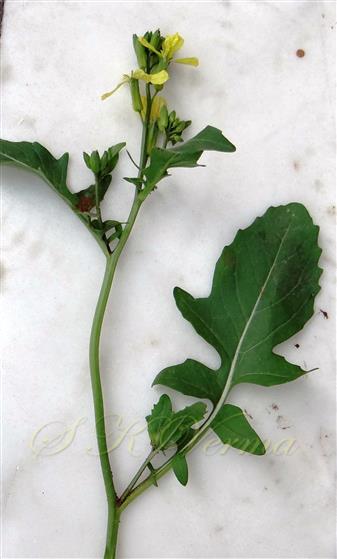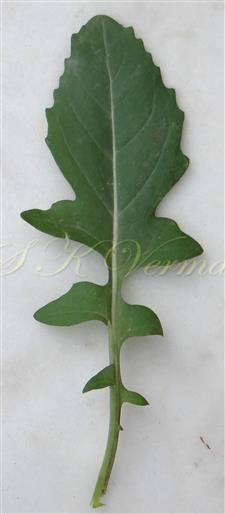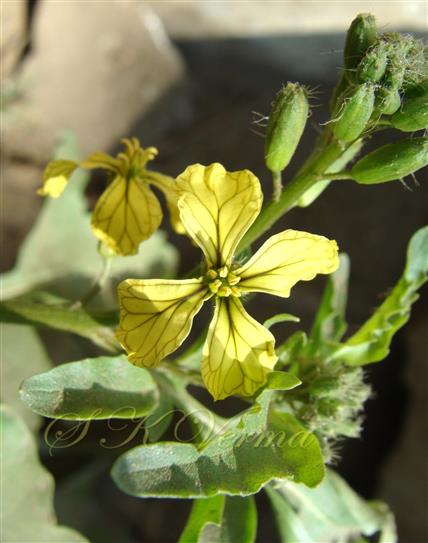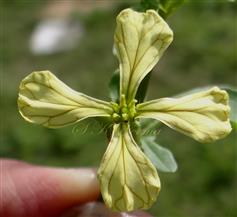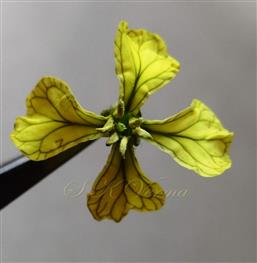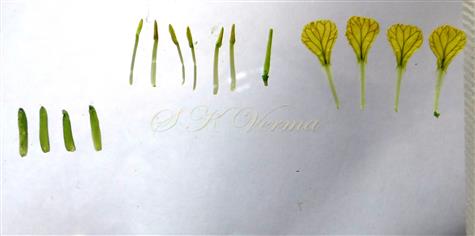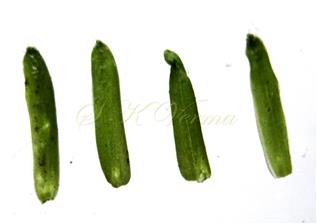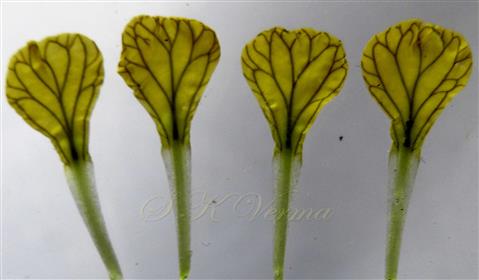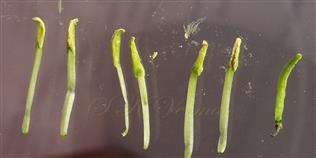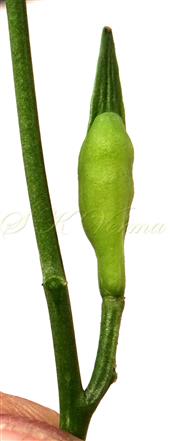ERUCA
Eruca
Mill., Gard. Dict. Arb., ed. 4. Vol. 1. 1754; Adans., Fam. 2: 418. 1763; Benth. & Hook. f., Gen. Pl. 1: 84.1862; Boiss., Fl. Or. 1: 395. 1867; Hook. f., Fl. Brit. Ind. 1:158. 1875; Fl. China @ eFloras.org 8: 24; Warwick, Fl. North Amer. @ eFloras.org 7: 434; Fl. Pak. @ eFloras.org.
Annual or perennial herbs; hispid, trichomes often retrose, sometimes simple. Stem erect or ascending, branched. Leaves lyrate-pinnatifid; lower petiolate, upper sessile or subsessile. Inflorescence corymbose raceme, ebracteate, lax, elongating considerably in fruit. Flowers large, usually dull yellowish with brown or violet-veined petals, shortly pedicellate. Sepals 4, erect, oblong, obtuse, subequal, inner pair subsaccate at the base. Petals 4, about twice as long as sepals, obovate, long-clawed. Stamens 6, strongly tetradynamous, filaments linear; anthers oblong, subobtuse at the apex. Nectar glands 4 or 2; lateral pair depressed-prismatic, median pair ovoid, oblong or absent. Ovary cylindrical, 13-50-ovuled, beak prominent, conical with a distinct bilobed stigma. Siliquae dehiscent, oblong or subellipsoid, 1-3 cm long, terete or slightly tetragonal, +/- turgid with a flat, conical, compressed seedless beak; valves with a prominent midvein; septum hyaline, not veined. Seeds biseriate, subglobose or ovoid, 1-2.5 mm long, brown.
6 species
Eruca sativa
Eruca sativa
Mill., Gard. Dict., ed. 8, 1. 1768; Hook. f., Fl. Brit. Ind. 1:158. 1875; Boiss., Fl. Or. 1: 396. 1867; Kaur & Sharma, Fl. Sirmaur 141. 2004; Dhaliwal & Sharma, Fl. Kullu Dist. 134. 1999; Fl. Pak. @ eFloras.org; E. vesicaria subsp. sativa (Mill.) Thell. in G. Hegi, Illustr. Fl. Mitt.-Eur. 4: 201. 1918; E. vesicaria var. sativa (Mill.) Thell., Fl. Adv. Montpellier: 260. 1912; Brassica eruca L., Sp. Pl. 667.1753.
Annual herbs, foetid, 25-50(-80) cm tall. Stem erect, simple, sometimes branched, usually hispid. Leaves lyrate to pinnatifid or pinnatisect, +/- fleshy; lower leaves subrosulate, shortly stalked, petiole 2-5(-7) cm long; 4-5-jugate, usually 7-15(-20) cm x 3-5 cm, blade widely oblanceolate; terminal lobe somewhat larger, usually ovate, obtuse, irregularly toothed; lateral lobes ovate-oblong; upper leaves 1-3-jugate, smaller, sessile or subsessile. Racemes 15-20-flowered, lax, up to 30 cm long in fruit. Flowers large, 1.5-2.5 cm across, whitish to dull yellow or dirty white. Sepals 4, 8-10 mm x 1.8-2 mm, oblong, +/- hairy, often pale violet. Petals 4, 15-22 mm x 5-6.5 mm, obovate, long-clawed, brown or violet-veined, apex truncate. Stamens 6, tetradynamous, smaller filaments 9-13 mm and larger 11-15 mm long; anthers 2.5-3.5 mm long. Nectar glands 4; lateral pair depressed-prismatic, median pair ovoid or oblong. Ovary cylindrical, ca. 10 mm, bilocular, 12-24 ovules, beak prominent, conical, about half the length of total ovary; stigma bilobed. Siliquae 15-30 mm x 3.5-4.5 mm, ovate-oblong to oblong-ellipsoid (including 6-8 mm long, sabre-shaped, compressed, seedless beak, with 5 parallel veins); valves with a prominent midvein only; seeds 6-12(-14) in each locule, ovoid or subglobose, 1.5-2.5 mm in diam., pale brown.
Common Names: Rocket Salad, Arugula; Tara Mira (Hindi)
